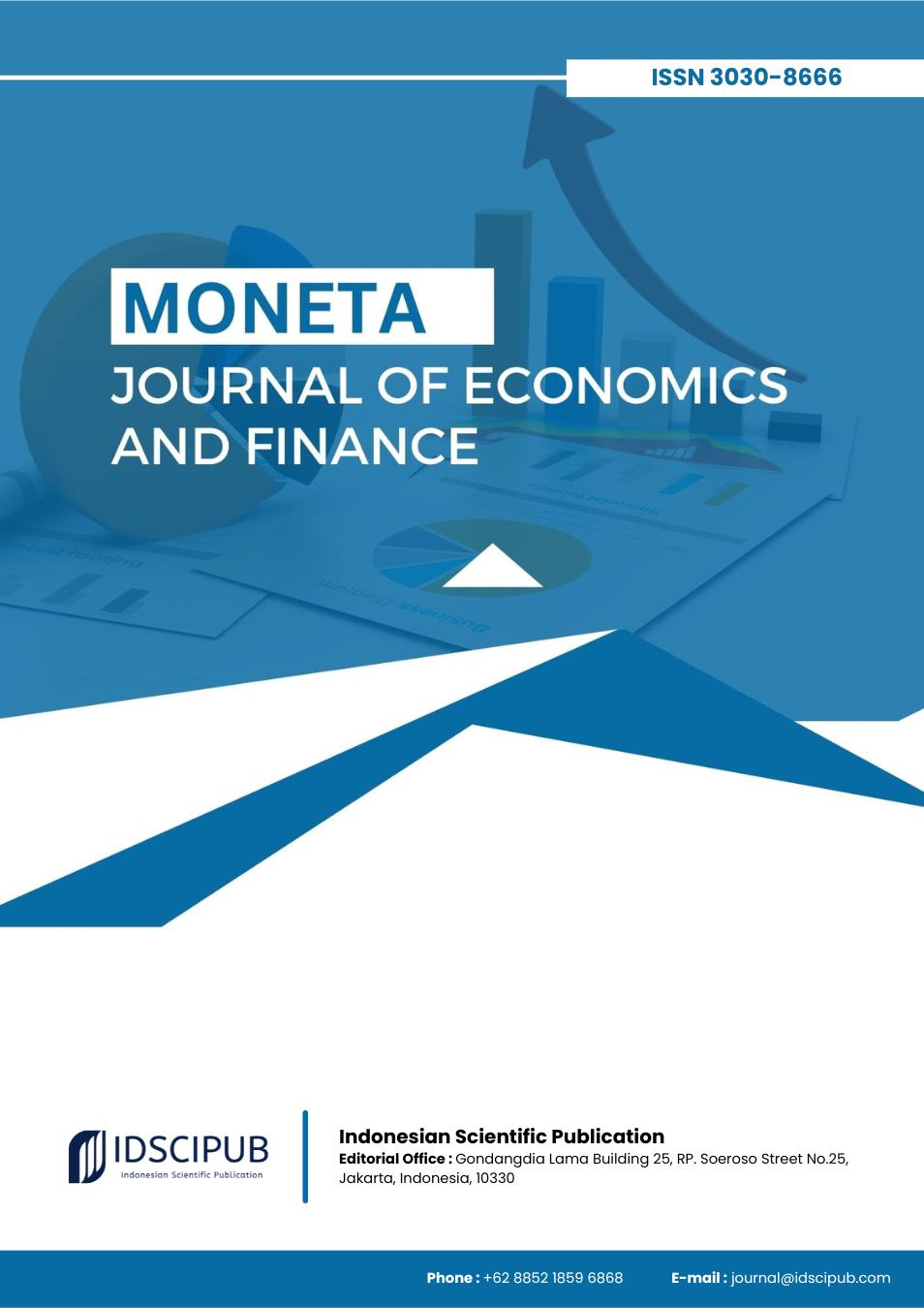Food Price Volatility and Agricultural Welfare in Emerging Economies: Evidence from Provincial Indonesia
DOI:
https://doi.org/10.61978/moneta.v2i3.824Keywords:
Food Price Volatility, Agricultural Terms of Trade, Inflation Targeting, GARCH, VECM, Indonesia, Rural WelfareAbstract
Food price volatility has emerged as one of the most pressing challenges for emerging economies, with Indonesia representing a critical case where agriculture sustains rural livelihoods and food accounts for more than 50% of household spending. This study addresses a gap in the literature by examining how food inflation and its volatility shape the agricultural terms of trade (NTP) across 34 provinces from 2017 to 2023. The research employs a mixed method econometric design, combining Vector Error Correction Models (VECM) and Two Stage GARCH models. VECM is used to explore both short run and long run relationships between inflation components and NTP, while GARCH captures the volatility effects of food prices and macroeconomic shocks, including exchange rate fluctuations and climate anomalies. Data were collected monthly from official Indonesian statistical sources, including BPS, Bank Indonesia, and BMKG. Results reveal that food inflation significantly influences NTP in both the short and long run, while core inflation remains statistically insignificant. Although farmers may initially gain from rising food prices, these gains are offset in the long term by rising input costs and supply chain constraints. The GARCH analysis confirms that volatility in food inflation undermines farmer welfare, with heterogeneous effects across provinces depending on agricultural structure and resilience to shocks. These findings highlight the limitations of Indonesia’s Inflation Targeting Framework (ITF) in addressing food price volatility and call for more inclusive policy strategies. Non-monetary interventions such as strategic food reserves, subsidies, and food distribution programs are recommended, alongside stronger coordination between monetary and agricultural institutions. Case studies from Brazil and Ghana further support integrated approaches that combine food security with macroeconomic planning. The study contributes to the literature by offering empirical insights into how inflation volatility affects agricultural welfare in an emerging economy. It advocates for a multi-dimensional policy framework to ensure rural resilience, equitable economic development, and food system stability in the face of growing macroeconomic uncertainties.
References
Abokyi, E., Folmer, H., & Asiedu, K. F. (2018). Public Buffer Stocks as Agricultural Output Price Stabilization Policy in Ghana. Agriculture & Food Security, 7(1). https://doi.org/10.1186/s40066-018-0221-1 DOI: https://doi.org/10.1186/s40066-018-0221-1
Adekunle, C. P., Akinbode, S. O., Shittu, A. M., & Momoh, S. (2020). Food Price Changes and Farm Households’ Welfare in Nigeria: Direct and Indirect Approach. Journal of Applied Economics, 23(1), 409–425. https://doi.org/10.1080/15140326.2020.1743103 DOI: https://doi.org/10.1080/15140326.2020.1743103
Aginta, H. (2023). Inflation and Spatial Spillovers in a Large Archipelago: Evidence From Indonesia*. Economic Papers a Journal of Applied Economics and Policy, 43(1), 91–103. https://doi.org/10.1111/1759-3441.12381 DOI: https://doi.org/10.1111/1759-3441.12381
Aginta, H., & Someya, M. (2022). Regional Economic Structure and Heterogeneous Effects of Monetary Policy: Evidence From Indonesian Provinces. Journal of Economic Structures, 11(1). https://doi.org/10.1186/s40008-021-00260-6 DOI: https://doi.org/10.1186/s40008-021-00260-6
Ahmad, F. S., Siregar, H., & Pasaribu, S. H. (2019). The Impact of El Nino on Inflation in Regional Indonesia: Spatial Panel Approach. Signifikan Jurnal Ilmu Ekonomi, 8(1), 51–70. https://doi.org/10.15408/sjie.v8i1.7130 DOI: https://doi.org/10.15408/sjie.v8i1.7130
Akter, S., & Basher, S. A. (2014). The Impacts of Food Price and Income Shocks on Household Food Security and Economic Well-Being: Evidence From Rural Bangladesh. Global Environmental Change, 25, 150–162. https://doi.org/10.1016/j.gloenvcha.2014.02.003 DOI: https://doi.org/10.1016/j.gloenvcha.2014.02.003
AlKhazraji, Z. (2024). Analysis of Causal and Integrative Relationship Between Inflation, Term of Trade and Food Prices in Iraq for 2000-2021. Al Kut Journal of Economic and Administrative Sciences, 16(50), 637–656. https://doi.org/10.29124/kjeas.1650.31 DOI: https://doi.org/10.29124/kjeas.1650.31
Aulia, A. (2022). Impact of Inflation on Main Food Commodities Prices in Central Java (2019-2021). Journal of Humanities Social Sciences and Business (Jhssb), 2(1), 75–89. https://doi.org/10.55047/jhssb.v2i1.381 DOI: https://doi.org/10.55047/jhssb.v2i1.381
Ayele, A. W., Gabreyohannes, E., & Tesfay, Y. Y. (2017). Macroeconomic Determinants of Volatility for the Gold Price in Ethiopia: The Application of GARCH and EWMA Volatility Models. Global Business Review, 18(2), 308–326. https://doi.org/10.1177/0972150916668601 DOI: https://doi.org/10.1177/0972150916668601
Banerjee, S. (2017). Empirical Regularities of Inflation Volatility: Evidence From Advanced and Developing Countries. South Asian Journal of Macroeconomics and Public Finance, 6(1), 133–156. https://doi.org/10.1177/2277978717695157 DOI: https://doi.org/10.1177/2277978717695157
Baumeister, C., & Kilian, L. (2014). Do Oil Price Increases Cause Higher Food Prices? Economic Policy, 29(80), 691–747. https://doi.org/10.1111/1468-0327.12039 DOI: https://doi.org/10.1111/1468-0327.12039
Brümmer, B., Korn, O., Schlüßler, K., & Jaghdani, T. J. (2015). Volatility in Oilseeds and Vegetable Oils Markets: Drivers and Spillovers. Journal of Agricultural Economics, 67(3), 685–705. https://doi.org/10.1111/1477-9552.12141 DOI: https://doi.org/10.1111/1477-9552.12141
Burhanuddin, B. (2020). Investigating Volatility Behaviour: Empirical Evidence From Islamic Stock Indices. Journal of Islamic Monetary Economics and Finance, 6(4), 729–746. https://doi.org/10.21098/jimf.v6i4.1256 DOI: https://doi.org/10.21098/jimf.v6i4.1256
Catão, L., & Chang, R. (2015). World Food Prices and Monetary Policy. Journal of Monetary Economics, 75, 69–88. https://doi.org/10.1016/j.jmoneco.2014.12.010 DOI: https://doi.org/10.1016/j.jmoneco.2014.12.010
Ceballos, F., Hernandez, M. A., Minot, N., & Robles, M. (2017). Grain Price and Volatility Transmission From International to Domestic Markets in Developing Countries. World Development, 94, 305–320. https://doi.org/10.1016/j.worlddev.2017.01.015 DOI: https://doi.org/10.1016/j.worlddev.2017.01.015
Chadwick, M. (2023). The Significance of Terms of Trade Shocks for Retail Food Prices in Turkey. Agribusiness, 39(4), 915–940. https://doi.org/10.1002/agr.21806 DOI: https://doi.org/10.1002/agr.21806
Devaguptapu, A., & Dash, P. (2021). Global Commodity Prices and Inflation Expectations. International Journal of Emerging Markets, 18(5), 1053–1077. https://doi.org/10.1108/ijoem-11-2020-1382 DOI: https://doi.org/10.1108/IJOEM-11-2020-1382
Duran, H. E., & Dindaroğlu, B. (2020). Regional Inflation Persistence in Turkey. Growth and Change, 52(1), 460–491. https://doi.org/10.1111/grow.12456 DOI: https://doi.org/10.1111/grow.12456
Göktaş, P. (2016). Can Unprocessed Food Prices Really Be One of the Main Responsible Causes for Not Achieving Inflation Targets in Turkey? Zeszyty Naukowe SGGW W Warszawie - Problemy Rolnictwa Światowego, 16(4), 99–114. https://doi.org/10.22630/prs.2016.16.4.103 DOI: https://doi.org/10.22630/PRS.2016.16.4.103
Hermaliza, H., Apridar, A., & Sartiyah, S. (2023). Investigating the Determinants of the Livestock Sub-Sector in Aceh Province, Indonesia. International Journal of Finance Economics and Business, 2(3), 238–245. https://doi.org/10.56225/ijfeb.v2i3.205 DOI: https://doi.org/10.56225/ijfeb.v2i3.205
Hossain, M. M. (2014). Pervasiveness of SERVQUAL and Its Potential for the Standards for Functional Quality of Service. International Journal of Services and Standards, 9(1), 67. https://doi.org/10.1504/ijss.2014.061061 DOI: https://doi.org/10.1504/IJSS.2014.061061
Hummida, D., Rahman, A., Majidi, N., Kasuma, J., Yacob, Y., Affizzah, D., & Marikan, A. (2019). Journal of International Business Economics and Entrepreneurship, 4(1). https://doi.org/10.24191/jibe.v4i1 DOI: https://doi.org/10.24191/jibe.v4i1
Ismaya, B. I., & Anugrah, D. F. (2018). Determinant of Food Inflation. Bulletin of Monetary Economics and Banking, 21(1), 81–94. https://doi.org/10.21098/bemp.v21i1.926 DOI: https://doi.org/10.21098/bemp.v21i1.926
Jamaludin, M. (2022). Indonesia’s Food Security Challenges: How Food SOE Optimizes Its Role? Research Horizon, 2(3), 394–401. https://doi.org/10.54518/rh.2.3.2022.394-401 DOI: https://doi.org/10.54518/rh.2.3.2022.394-401
Liu, D., Xu, B., Song, Y., & Liu, T. (2024). Solving the Puzzle of China’s Low Inflation: A New Perspective From Sectoral Core Inflation Fluctuations. Technological and Economic Development of Economy, 30(3), 783–808. https://doi.org/10.3846/tede.2024.20532 DOI: https://doi.org/10.3846/tede.2024.20532
Mittal, S., Hariharan, V. K., & Subash, S. (2018). Price Volatility Trends and Price Transmission for Major Staples in India. Agricultural Economics Research Review, 31(1), 65. https://doi.org/10.5958/0974-0279.2018.00006.x DOI: https://doi.org/10.5958/0974-0279.2018.00006.X
Mokni, K. (2023). Detrended Cross-Correlations Analysis Between Oil Shocks and World Food Prices. International Journal of Energy Sector Management, 18(1), 183–199. https://doi.org/10.1108/ijesm-10-2021-0019 DOI: https://doi.org/10.1108/IJESM-10-2021-0019
Mukhlish, R. S., & Wahyuningsih, D. (2020). Inflation Convergence and the Determinant Factors: A Case Study on 31 Provinces in Indonesia. Jurnal Perspektif Pembiayaan Dan Pembangunan Daerah, 7(4), 421–430. https://doi.org/10.22437/ppd.v7i4.8648 DOI: https://doi.org/10.22437/ppd.v7i4.8648
Mustafa, A. M. M., & Sivarajasingham, S. (2019). Dynamic Linkages Between Food Inflation and Its Volatility: Evidence From Sri Lankan Economy. Journal of Asian Finance Economics and Business, 6(4), 139–145. https://doi.org/10.13106/jafeb.2019.vol6.no4.139 DOI: https://doi.org/10.13106/jafeb.2019.vol6.no4.139
Nortey, E. N., Ngoh, D. D., Doku-Amponsah, K., & Ofori‐Boateng, K. (2015). Modeling Inflation Rates and Exchange Rates in Ghana: Application of Multivariate GARCH Models. Springerplus, 4(1). https://doi.org/10.1186/s40064-015-0837-6 DOI: https://doi.org/10.1186/s40064-015-0837-6
Nurhayati, N., Kusuma, D., Tarigan, A., Siregar, P. A., Hasibuan, R. R. A., & Ahsan, A. (2022). Exposure to Outdoor Tobacco Advertisements Near Home Is Associated With Smoking Among Youth in Indonesia. Asian Pacific Journal of Cancer Prevention, 23(7), 2179–2183. https://doi.org/10.31557/apjcp.2022.23.7.2179 DOI: https://doi.org/10.31557/APJCP.2022.23.7.2179
Oláh, J., Lengyel, P., Balogh, P., Harangi–Rákos, M., & Popp, J. (2017). The Role of Biofuels in Food Commodity Prices Volatility and Land Use. Journal of Competitiveness, 9(4), 81–93. https://doi.org/10.7441/joc.2017.04.06 DOI: https://doi.org/10.7441/joc.2017.04.06
Olayemi, M. S., Olubiyi, A. O., Olajide, O. O., & Ajayi, O. F. (2021). Modelling the Efficiency of TGARCH Model in Nigeria Inflation Rate. Journal of Statistical Modelling and Analytics, 3(2), 20–35. https://doi.org/10.22452/josma.vol3no2.2 DOI: https://doi.org/10.22452/josma.vol3no2.2
Paul, U. K., Das, G., Das, M., & Mathur, T. (2020). Small Growers’ Direct Participation in the Market and Its Impact on Farm Income. Journal of Agribusiness in Developing and Emerging Economies, 11(3), 241–254. https://doi.org/10.1108/jadee-05-2019-0067 DOI: https://doi.org/10.1108/JADEE-05-2019-0067
Peng, P., & Xu, Z. (2023). Subjective Preferences, Liquidity Constraints and Price Risk Management Under Large-Scale Farm Management. China Agricultural Economic Review, 16(1), 76–96. https://doi.org/10.1108/caer-12-2022-0287 DOI: https://doi.org/10.1108/CAER-12-2022-0287
Pescatori, A., Bogmans, C., & Prifti, E. (2021). Income Versus Prices: How Does the Business Cycle Affect Food (In)-Security? Imf Working Paper, 2021(238), 1. https://doi.org/10.5089/9781557752468.001 DOI: https://doi.org/10.5089/9781557752468.001
Pourroy, M., Carton, B., & Coulibaly, D. (2016). Food Prices and Inflation Targeting in Emerging Economies. International Economics, 146, 108–140. https://doi.org/10.1016/j.inteco.2015.12.001 DOI: https://doi.org/10.1016/j.inteco.2015.12.001
Pratikto, R., & Ikhsan, M. (2016). Inflasi Makanan Dan Implikasinya Terhadap Kebijakan Moneter Di Indonesia. Jurnal Ekonomi Dan Pembangunan Indonesia, 17(1), 58–74. https://doi.org/10.21002/jepi.v17i1.658 DOI: https://doi.org/10.21002/jepi.v17i1.658
Rahmanta, R., & Maryunianta, Y. (2020). Pengaruh Harga Komoditi Pangan Terhadap Inflasi Di Kota Medan. Jurnal Agrica, 13(1). https://doi.org/10.31289/agrica.v13i1.3121 DOI: https://doi.org/10.31289/agrica.v13i1.3121
Rastogi, S., & Kanoujiya, J. (2022). The Volatility Spillover Effect of Macroeconomic Indicators and Strategic Commodities on Inflation: Evidence From India. South Asian Journal of Business Studies, 13(2), 180–200. https://doi.org/10.1108/sajbs-10-2021-0387 DOI: https://doi.org/10.1108/SAJBS-10-2021-0387
Rohimuddin, & Panjawa, J. L. (2022). The Impact of Food Commodity Prices on Inflation in Bekasi. Marginal Journal of Management Accounting General Finance and International Economic Issues, 2(1), 193–206. https://doi.org/10.55047/marginal.v2i1.376 DOI: https://doi.org/10.55047/marginal.v2i1.376
Samal, A., & Goyari, P. (2022). Does Monetary Policy Stabilise Food Inflation in India? Evidence From Quantile Regression Analysis. Australian Economic Review, 55(3), 361–372. https://doi.org/10.1111/1467-8462.12474 DOI: https://doi.org/10.1111/1467-8462.12474
Seaman, J., Sawdon, G. E., Acidri, J., & Petty, C. (2014). The Household Economy Approach. Managing the Impact of Climate Change on Poverty and Food Security in Developing Countries. Climate Risk Management, 4–5, 59–68. https://doi.org/10.1016/j.crm.2014.10.001 DOI: https://doi.org/10.1016/j.crm.2014.10.001
Sekhar, C. S. C., Roy, D., & Bhatt, Y. C. (2018). Food Inflation and Volatility in India: Trends and Determinants. Indian Economic Review, 53(1–2), 65–91. https://doi.org/10.1007/s41775-018-0017-z DOI: https://doi.org/10.1007/s41775-018-0017-z
Setiawan, A. F., & Hadianto, A. (2014). Fluktuasi Harga Komoditas Pangan Dan Dampaknya Terhadap Inflasi Di Provinsi Banten. Journal of Agriculture Resource and Environmental Economics, 1(2), 81–97. https://doi.org/10.29244/jaree.v1i2.11804 DOI: https://doi.org/10.29244/jaree.v1i2.11804
Šoškić, D. (2015). Inflation Impact of Food Prices: Case of Serbia. Ekonomika Poljoprivrede, 62(1), 41–51. https://doi.org/10.5937/ekopolj1501041s DOI: https://doi.org/10.5937/ekoPolj1501041S
Uduji, J. I., Okolo‐Obasi, E. N., & Asongu, S. (2020). Analysis of Farmers’ Food Price Volatility and Nigeria’s Growth Enhancement Support Scheme. African Journal of Science Technology Innovation and Development, 13(4), 463–478. https://doi.org/10.1080/20421338.2020.1814516 DOI: https://doi.org/10.1080/20421338.2020.1814516
Wardan, W., Basuki, P., Firmansyah, M., Sahri, S., & Irwan, M. (2024). Analysis of the Influence of Poverty, Unemployment, Inflation and Investment on Economic Growth in West Nusa Tenggara Province 2012-2022. Journal of Economics Finance and Management Studies, 07(07). https://doi.org/10.47191/jefms/v7-i7-51 DOI: https://doi.org/10.47191/jefms/v7-i7-51
Yang, F., Bekkers, E., Brockmeier, M., & François, J. (2015). Food Price Pass‐Through and the Role of Domestic Margin Services. Journal of Agricultural Economics, 66(3), 796–811. https://doi.org/10.1111/1477-9552.12110 DOI: https://doi.org/10.1111/1477-9552.12110
Yelamanchili, R. K. (2020). Modeling Stock Market Monthly Returns Volatility Using GARCH Models Under Different Distributions. International Journal of Accounting & Finance Review, 5(1), 42–50. https://doi.org/10.46281/ijafr.v5i1.425 DOI: https://doi.org/10.46281/ijafr.v5i1.425
Zmami, M., & Ben‐Salha, O. (2023). What Factors Contribute to the Volatility of Food Prices? New Global Evidence. Agricultural Economics (Zemědělská Ekonomika), 69(5), 171–184. https://doi.org/10.17221/99/2023-agricecon DOI: https://doi.org/10.17221/99/2023-AGRICECON






